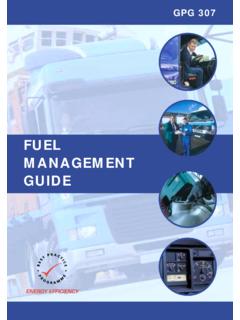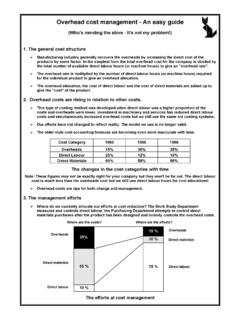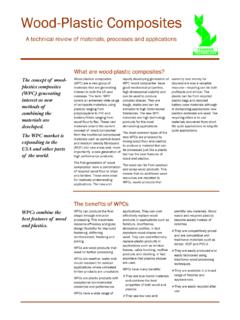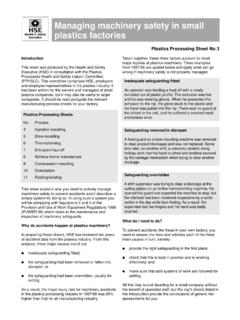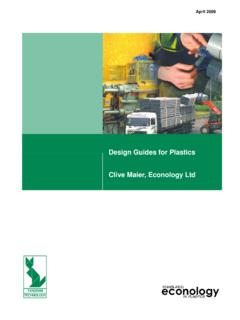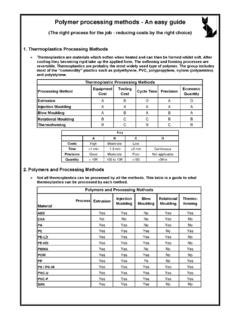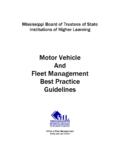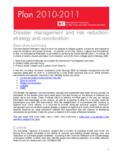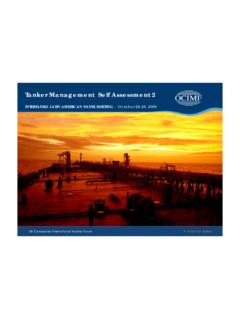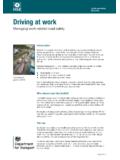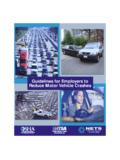Transcription of GOOD PRACTICE GUIDE - Tangram
1 best PRACTICEPROGRAMMEGOOD PRACTICE GUIDE 318 Transport and EnvironmentalManagement SystemsGOOD PRACTICE GUIDE and management Transport Needs of of Managing the Environmental Impacts of Transport42 Integration in the EMS EMS and Transport Environmental Aspects and the Significance of Chain Issues - Managing Impacts and Influencing Partners173 Managing Transport in Your and Monitoring Transport Objectives and the Environmental Impacts from Engagement (Workforce, Suppliers, Customers etc.) the best Out of the New Systems284 EMS the Development305 Transport and the Environment366 Where to Find Out More41 CONTENTSiGPG318 This version published 03/02 TRANSPORT & ENVIRONMENTAL management SYSTEMSTRANSPORT & ENVIRONMENTAL management SYSTEMSThis good PRACTICE GUIDE on transport and Environmental management Systems is part ofa series of guides prepared under the Energy Efficiency best PRACTICE Programme. Particularthanks go to those who contributed to this GUIDE as external verifiers, including: Carey Newson- Assistant Director (Partnership & good PRACTICE ) Transport 2000; Zelda Bentham- Environmental management Consultant at CGNU plc; and Andy Simcock- Responsible for environmental affairs at Kier Construction Group by:Future Energy Solutions, Harwell, Didcot, Oxfordshire OX11 0QJ andEnviros Aspinwall, 16 Crucifix Lane, London Bridge, London.
2 SE1 3 JWiiGPG318 This version published 03/02 FOREWORDTRANSPORT & ENVIRONMENTAL management SYSTEMSThis GUIDE seeks to promote theintegration of transport initiatives andenvironmental management systems(EMS) and to help businesses and otherorganisations identify and manage theenvironmental impacts of their transportoperations in a way that is consistentwith managing the other environmentalaspects of their GUIDE is divided into six sectionsaddressing the following issues: Section 1: Introductioncovers theaims and objectives of this GUIDE , andexplores the benefits fororganisations of managing transportas part of an EMS. Section 2: Integration Processdescribes the manner in whichtransport initiatives may be integratedinto existing or proposed managementsystems, and EMSs in particular. Thissection also addresses the issue ofidentifying, recording and evaluatingenvironmental impacts and aspects. Section 3: Managing Transportprovides guidelines for measuring andmonitoring transport impacts andsetting objectives and targets aimed ataddressing these impacts.
3 It alsosuggests a range of measures that helpreduce the environmental impacts,including travel plans, fuelmanagement and fleet management . Section 4: EMS Checklistincludes aseries of checklists designed to assistin the development of an EMS wherethe impacts of transportation havebeen considered and are integrated inthe system. Section 5: Transport and theEnvironmentdescribes the impacts oftransport on the environment andprovides useful backgroundinformation, references and statistics. Section 6: Where to Find Out Moreprovides useful references to relateddocuments, contacts and webresources which may be PURPOSE ANDOBJECTIVESThe GUIDE is aimed at managers withresponsibility for environmentalperformance within companies. It sets outpractical advice on how to reducetransport-related environmental impactsand to monitor the improvements is also intended for transport managers,to provide an understanding of how themanagement of the environmentalimpacts associated with transport relates tothe wider management of environmentaland cost performance.
4 Finally, the guideseeks to raise awareness among auditors ofenvironmental management systems toensure transport is considered organisations are already workingeither on EMSs or travel plans. Travelplans are strategies designed to reduce thereliance of staff on using the car for workand lend themselves to forming part of awider objectives of this GUIDE are toprovide a basis for environment ortransport managers and EMS auditors to: understand better where transportationrelated environmental impacts arise ina business and what these impacts are;INTRODUCTION1 GPG318 This version published 03/021 TRANSPORT & ENVIRONMENTAL management SYSTEMS evaluate whether their company stransport related environmentalimpacts are significant within thecontext of their overallenvironmental impact; understand the process for integratingall alternative transport initiativesinto the EMS process; identify ways to measure, assess andmonitor the environmental impactsof transport; be guided towards measures forcontinuous improvement.
5 Find further sources of informationand recent EEBPP study has indicated thatmany companies do not recognise theenvironmental consequences of transportassociated with their business in companies where formalenvironmental management systems arein place, only 20% with EMAS and 55%of those with ISO 14001 identifytransport as a significant environmentalaspect or plays an important role in mostbusiness activities. It has long beenrecognised that economic growth typicallyincreases the amount of travel. However,transport is also recognised as a majorsource of environmental impacts, whichwill need to be considered besides otherenvironmental impacts as part of anenvironmental management system. ENVIRONMENTALMANAGEMENT SYSTEMSO rganisations of all sizes are increasinglyfocusing on the potential environmentalimpacts of their activities, products orservices, as concern grows for maintainingand improving the quality of theenvironment and protecting humanhealth. The environmental performance ofan organisation is of increasing importanceto interested parties, both internally andexternally.
6 Meeting these expectationsrequires organisational commitment to asystematic approach and to continualimprovement in environmentalperformance, which can be achievedthrough implementation of anenvironmental management system (EMS).EMS s are organisational systems forcontrolling, managing and improving theenvironmental impact of are currently two internationallyrecognised EMS schemes that can beexternally verified. These are theinternational standard, ISO 14001, andthe EU Eco- management and AuditScheme (EMAS). The ISO standard inparticular has made a global impression -to the end of 1999, 14,106 ISO 14001certificates were held in 84 , it is now an accepted coreelement of systems required by EMAS,which applies to all EU Member States aswell as other European Economic AreaMember States. In early 2001, 3134 siteswere registered for the UK, both private companies andpublic sector bodies are adopting thesestandard approaches to environmentalmanagement. Many industry bodiesprovide support to their members inimplementing verified EMS, as do otherbusiness support organisations such as theSmall Business Service.
7 As part of the2 GPG318 This version published 03/021 INTRODUCTION1 For more information on the European Union s Eco- management and Audit Scheme (EMAS) and the InternationalOrganisation for Standardisation s standard on environmental management systems (ISO 14001), see Section & ENVIRONMENTAL management SYSTEMS Greening Government initiative, theuse of systems based on ISO 14001principles is being advocated inGovernment organisations at all levels,and in related bodies in the public sector,such as hospitals, universities and policeforces. More detail on the specific stepsinvolved in implementing an EMS isgiven in Section implementation of an EMS isnot without cost, in the long term itshould save an organisation money,improve its environmental performanceand reduce its risks of environmentalprosecution, thereby giving a competitiveadvantage. The EMS will also help anorganisation to demonstrateenvironmental responsibility tostakeholders including THE TRANSPORT NEEDSOF ORGANISATIONSIn most organisations, transport impactswill arise due to: travel by employees between work andhome; business travel, such as employeestravelling to meetings (includingjourneys made by air), a salesteam may spend most of its time onthe road; deliveries made by goods and servicevehicles operating as part of theorganisation s activities; travel by visitors to and from aparticular site, visitors to aworkplace, shoppers to a retail outlet,patients to a hospital and tourists to aleisure attraction; deliveries to the site made on behalf ofanother transportation profile of anorganisation varies between businesstypes and, in turn, so do itsenvironmental impacts and the measuresneeded to address these impacts.
8 In orderto implement a programme of actionappropriate to the nature and scale ofactivities carried out at any particular site,consideration should be given to whereand how much use of transport occurs inan organisation s activities. Theoccurrence and scale of transport needswithin an individual organisation may beassessed on the following basis: Commuting: The number of tripsmade to and from work may initiallybe estimated on the basis of thenumber of employees. A travel surveywould provide more accurateinformation about mode share,distances travelled etc. Business travel: The number of poolcars available within the organisationand the number of cars rented by theorganisation may serve as an initialindication of the extent of businesstravel. A listing of travel expenses (forrail, bus, taxi, aircraft), log bookrecords, fuel consumption data, andmileage records would allow for a moreaccurate estimate of business travel. Visitor travel:An estimate of theextent of visitor travel to theorganisation may be obtained from areview of visitor books, and may befollowed by a more accurate visitorsurvey on how and how far theytravelled.
9 Deliveries:Delivery records andvisitor books would provide an initialINTRODUCTION3 GPG318 This version published 03/021 TRANSPORT & ENVIRONMENTAL management SYSTEMS indication of the number of deliveriesto the organisation, and may befollowed by a more detailed survey. Fleet vehicles:The number oftransport operations which form partof the organisation s business activitiesmay initially be estimated on the basisof the number of fleet vehicles ownedor operated by the organisation. Logbook records, fuel consumption dataand mileage records would allow for amore accurate individual needs can be comparedwith each other in terms of their scale,and the extent and magnitude of theenvironmental impacts that may resultfrom them. For example, for organisationswhere distribution is a key element inproduction, the impacts associated withfleet vehicles may be more importantthan those linked to , impacts associated withtransport needs can be compared withother types of environmental impacts onthis basis also.
10 This will be part of theprocess of identifying and evaluating theenvironmental aspects of anorganisation s activities, which isdescribed in Section BENEFITS OF MANAGINGTHE ENVIRONMENTALIMPACTS OF TRANSPORTThe transport needs of an organisationaffect the environment in a number ofways. To ensure transport is wellintegrated it is important to appreciatefully the related impacts. Furtherinformation on transport-related impactscan be found in Section an organisation senvironmental effects associated with themovement of goods and people can havea wide range of positive effects, bringingbenefits not only to the organisationimplementing the initiatives and its staff,but also to the wider community. Thesemay include: Cost savings through reduced fueland other transport costs: Fuel costis a major element of the total fleetoperating costs - typically it will makeup 25% of the total running cost ofthe vehicle. Efficient use of transportwill improve business effectivenessand profitability. The EEBPP GuideFuel-efficient fleet management (GPG218) shows how effective fleetmanagement can release typicalsavings of 10%.
